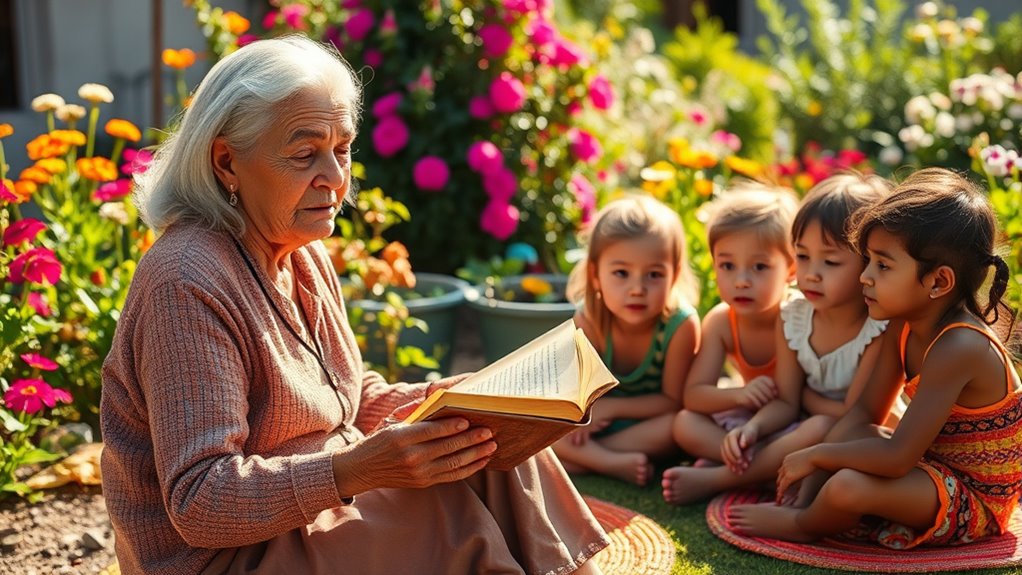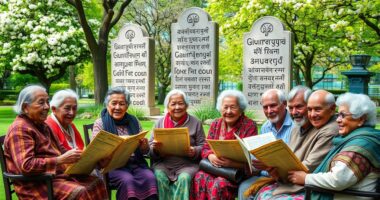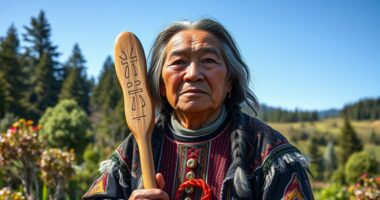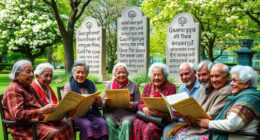Mentorship in language learning allows elders to share their stories, traditions, and cultural knowledge directly with new generations. By passing down language through storytelling, music, and practical activities, they create authentic and memorable experiences. This process not only helps preserve the language but also strengthens community bonds and cultural identity. The benefits are mutual; elders gain fulfillment, while younger learners acquire skills and a deeper understanding of their heritage. Keep exploring to discover how this powerful exchange continues to thrive.
Key Takeaways
- Elders share cultural stories and traditions, enriching language learning with authentic context.
- Intergenerational mentorship fosters cultural preservation and strengthens community bonds.
- Personalized teaching methods leverage elders’ experience to address learners’ unique needs.
- Technology facilitates remote mentorship, enabling ongoing language and cultural exchange.
- Mutual engagement promotes active learning through storytelling, music, and traditional practices.

Have you ever wondered how some people master a new language so quickly? One powerful way to accelerate your learning is through mentorship, especially when elders take on the role of teachers for younger generations. When elders share their language skills, it creates a meaningful intergenerational exchange that benefits everyone involved. This exchange isn’t just about vocabulary and grammar; it’s a bridge connecting different ages, experiences, and perspectives. As you learn from someone who has lived through history and cultural shifts, you gain insights that go far beyond textbooks. The elder’s stories, traditions, and personal anecdotes deepen your understanding of the language’s cultural context, making your learning more authentic and memorable.
Engaging in this kind of mentorship fosters cultural preservation, which is *vital* in a rapidly changing world. When elders pass down their language skills, they’re also transmitting traditions, beliefs, and social norms that might otherwise fade away. You get to be part of a process that keeps your cultural identity alive, strengthening a sense of community and belonging. This isn’t a one-sided effort; it’s a mutual exchange where both sides grow. You bring your curiosity, energy, and fresh perspective, while elders offer their wisdom, patience, and depth of experience. Together, you create a vibrant learning environment that nurtures both language and cultural continuity.
As you participate in these intergenerational exchanges, you’ll notice that learning becomes more engaging and meaningful. Elders often use storytelling, music, and traditional practices, making lessons lively and relevant. Their age and life experience enable them to tailor their teaching to your needs, often sharing practical tips and cultural insights that you can’t find in a textbook. This mentorship also helps bridge generational gaps, fostering respect and understanding. You start to see language as more than just a tool for communication; it becomes a vessel carrying your heritage and identity. Additionally, technology can be a valuable tool in supporting these mentorship connections, making it easier to share and preserve linguistic and cultural knowledge across distances.
Frequently Asked Questions
How Do Elders Adapt Teaching Methods for Younger Learners?
Elders adapt their teaching methods for younger learners by engaging in intergenerational communication, making lessons relevant and relatable. They use storytelling, visual aids, and interactive activities to connect culturally and emotionally. Elders also embrace cultural adaptation, blending traditional and modern techniques to suit the learning style of youth. This approach fosters trust, understanding, and effective language retention, ensuring the transmission of cultural values across generations.
What Challenges Do Elder Mentors Face in Modern Language Education?
You might face challenges like generational gaps, making it harder to connect with younger learners’ interests and communication styles. Technological barriers can also slow your progress, as you may struggle to adopt new digital tools and platforms that are essential in modern language education. These obstacles require patience and adaptability, but overcoming them helps you bridge the gap and effectively share your knowledge with the next generation.
How Can Technology Support Elder-Led Language Mentorship Programs?
You can support elder-led language mentorship programs by integrating technology like digital storytelling and mobile learning. These tools make lessons more engaging and accessible, allowing elders to share stories and cultural knowledge easily. Mobile apps enable flexible learning schedules, helping elders connect with learners anywhere. Digital storytelling preserves traditions and enhances language retention, making mentorship more interactive and meaningful for both elders and learners.
What Cultural Factors Influence Elder Participation in Language Teaching?
You’ll find that intergenerational respect greatly influences elder participation in language teaching, as many cultures value elders’ wisdom and experience. Cultural storytelling also plays a key role, as elders often see sharing stories as a way to preserve traditions and strengthen community bonds. These factors motivate elders to engage actively in language mentorship, ensuring cultural heritage is passed down while fostering meaningful intergenerational connections.
How Is the Effectiveness of Elder Mentorship Measured in Language Retention?
You can measure the effectiveness of elder mentorship by evaluating community engagement and improvements in language proficiency. Observe how actively participants participate in language activities and community events, showing increased confidence and usage. Conduct language assessments before and after mentorship programs to track proficiency gains. Feedback from learners about their ability to use the language in real-life situations also indicates success. These measures help you understand how well elders support language retention.
Conclusion
As you step into this timeless dance of mentorship, imagine the stories you’ll share and the lives you’ll touch. The elders’ wisdom will open doors you never knew existed, guiding you through uncharted linguistic waters. But beneath every lesson lies a hidden promise—what secrets will be revealed when generations finally meet? Keep listening, keep learning, because the greatest treasures are waiting just beyond the next word, the next connection, the next discovery.
Mary is a passionate writer who brings creativity and a fresh perspective to our team. Her words have the power to captivate and inspire, making her an essential contributor to our content. Mary’s commitment to storytelling and dedication to promoting Indigenous culture ensures that her work touches the hearts of our readers. We’re fortunate to have her as part of our team.









